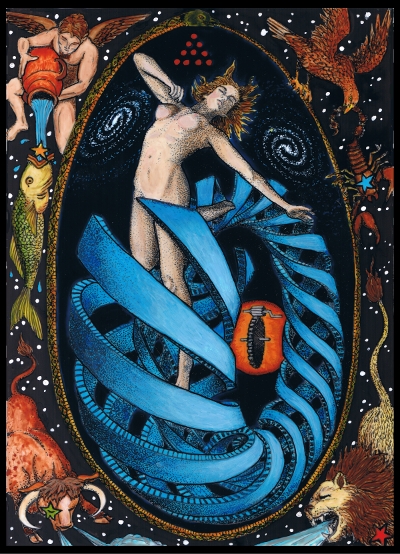The third and final (in more ways than one) decan of Gemini corresponds to the tarot Ten of Swords, the Lord of Ruin, ruled by the Sun. As Gemini, again we have twinned beings, but this time, just like in the Gemini mythos of Castor and Pollux, one twin must die.
777 lists the decan image as “A man in mail, armored with bow, arrows, and quiver“. 36 Airs of the Zodiac associates the decan with Praxidike, the executor, the dispenser of justice, and mother of the Erinyes (Furies). Praxidike was also an epithet of Persephone, who dispensed final justice in her role as Queen of the Underworld and the dead.
This decan also has the flavor of finality for another reason, as it was the last decan of the Egyptian year, and ends just as the Summer Solstice in the Northern hemisphere begins. The Oak King, or the Sun King, or the Green Knight – whatever you want to name him, must die here, sacrificed for the fertility of the land. At the Solstice, the days reach their longest, the Sun reaches it’s full strength only to begin the inevitable period of its waning.
During this days of this decan, the Sun appears above and behind the head of the constellation Orion – though you can’t see it, he appears to wear the Sun like a hat – or a head. As Solstice passes and the Sun proceeds into the next decan of Cancer, it descends from his shoulders as if stricken off by a sword. So while pondering this I realized that the “man in mail, armored with bow, arrows, and quiver” could indeed be an Orion figure. Depictions of the constellation sometimes show him with a sword in one hand held overhead and a bow in the other in front of him. Some illustrations have the bow replaced with either a lion’s pelt or a shield, but to me when I look at the constellation I see a belted warrior armed with a curving bow.
The constellation Orion is right next to that of the constellation Gemini, whose stars distinctly show two twins. Most often we think of these as Castor and Pollux – one mortal and one immortal. Yet history has many stories of twins or brothers, one of whom is slain, sometimes by the other. There is the story of Horus and Set, battling over the right for kingship, and a symbolic battle of light and darkness, that we see hinted at in the hilts of the two swords closest to the foreground.
[coming soon]
Want to follow along with the creation of this deck? Sign up for the newsletter! No spam and your info is never shared. It comes out monthly if all is going well, though sometimes a month gets skipped!
